English Workbook Submission for TMA 03 - Analysis of Texts
VerifiedAdded on 2020/11/23
|37
|9803
|209
Homework Assignment
AI Summary
This document represents an English workbook submission for TMA 03, focusing on the analysis of children's literature and various text types. The assignment begins with an ethical statement addressing confidentiality and anonymity, adhering to BERA guidelines and the Data Protection Act 1998. Part 1 explores language and literacy subject knowledge, providing detailed examples of children's literature, including picture books (for early and older readers), poems, novels, and information books. Each example is analyzed for its features of interest and aspects that support children's language and literacy learning. Part 2 delves into text types, defining and providing examples of narrative, recount, explanation, report, discussion, persuasion, and procedural texts. Key elements and examples from various sources, including newspapers and children's books, are outlined for each text type. References for the literature and text types are also provided.
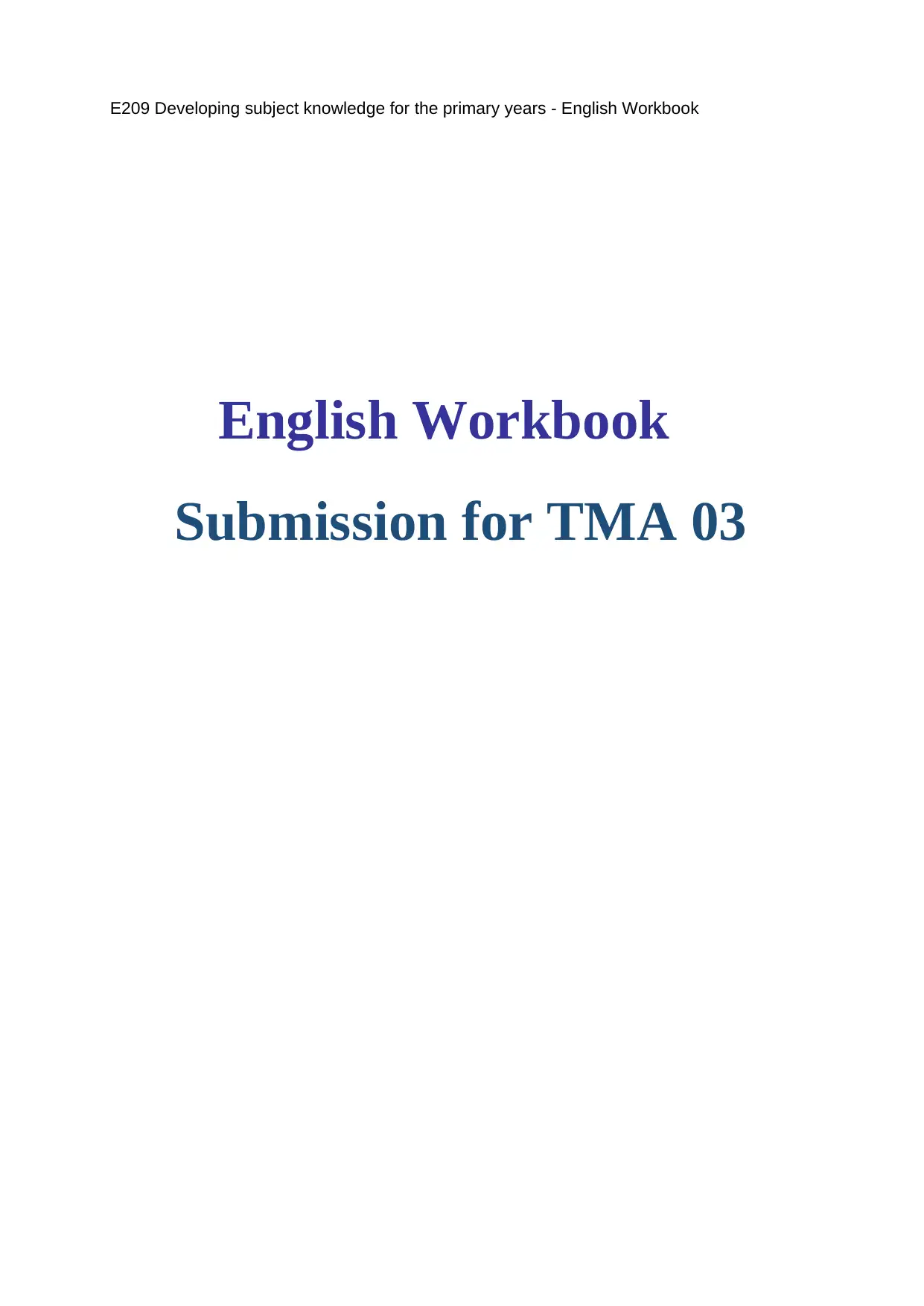
E209 Developing subject knowledge for the primary years - English Workbook
English Workbook
Submission for TMA 03
English Workbook
Submission for TMA 03
Paraphrase This Document
Need a fresh take? Get an instant paraphrase of this document with our AI Paraphraser
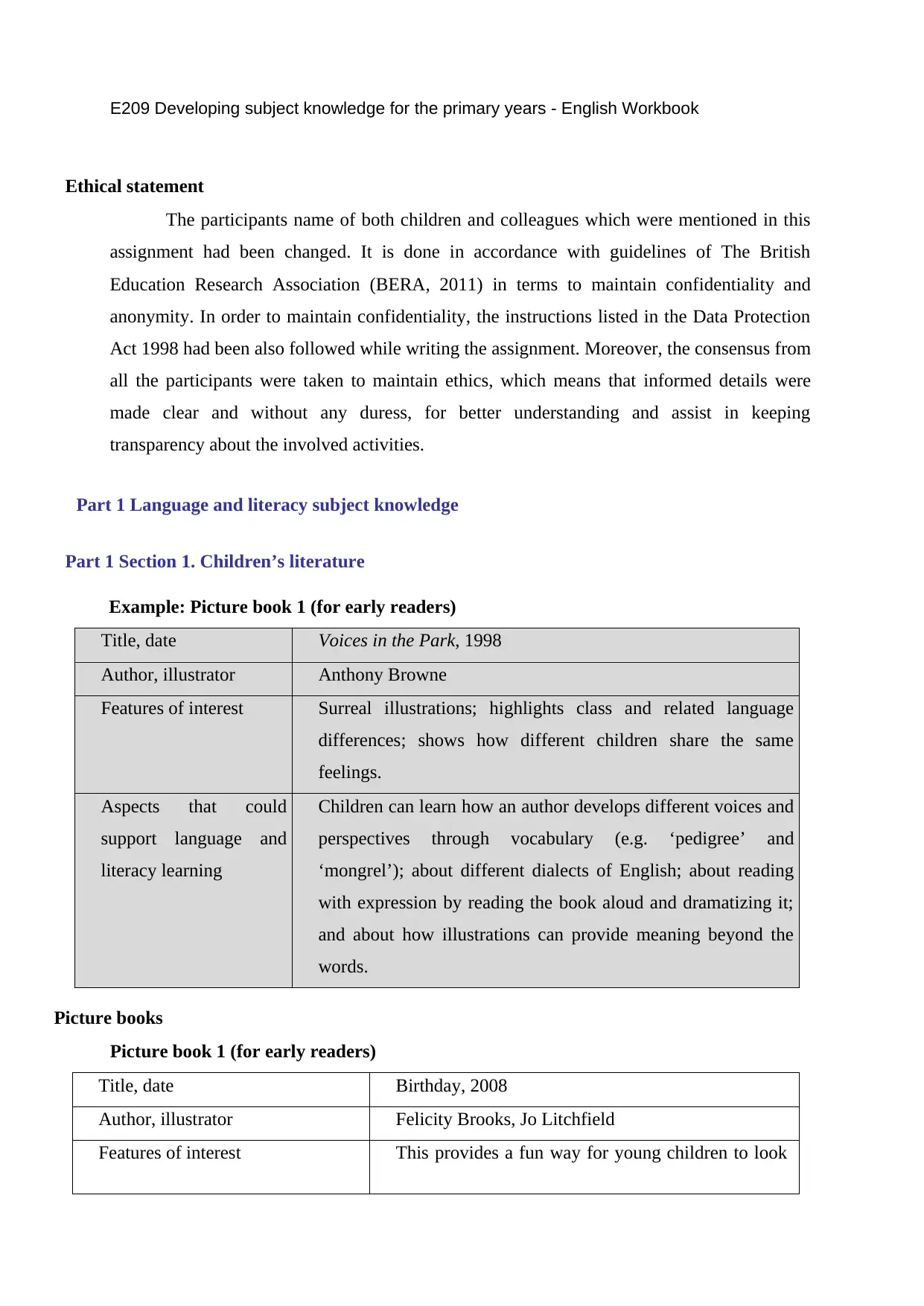
E209 Developing subject knowledge for the primary years - English Workbook
Ethical statement
The participants name of both children and colleagues which were mentioned in this
assignment had been changed. It is done in accordance with guidelines of The British
Education Research Association (BERA, 2011) in terms to maintain confidentiality and
anonymity. In order to maintain confidentiality, the instructions listed in the Data Protection
Act 1998 had been also followed while writing the assignment. Moreover, the consensus from
all the participants were taken to maintain ethics, which means that informed details were
made clear and without any duress, for better understanding and assist in keeping
transparency about the involved activities.
Part 1 Language and literacy subject knowledge
Part 1 Section 1. Children’s literature
Example: Picture book 1 (for early readers)
Title, date Voices in the Park, 1998
Author, illustrator Anthony Browne
Features of interest Surreal illustrations; highlights class and related language
differences; shows how different children share the same
feelings.
Aspects that could
support language and
literacy learning
Children can learn how an author develops different voices and
perspectives through vocabulary (e.g. ‘pedigree’ and
‘mongrel’); about different dialects of English; about reading
with expression by reading the book aloud and dramatizing it;
and about how illustrations can provide meaning beyond the
words.
Picture books
Picture book 1 (for early readers)
Title, date Birthday, 2008
Author, illustrator Felicity Brooks, Jo Litchfield
Features of interest This provides a fun way for young children to look
Ethical statement
The participants name of both children and colleagues which were mentioned in this
assignment had been changed. It is done in accordance with guidelines of The British
Education Research Association (BERA, 2011) in terms to maintain confidentiality and
anonymity. In order to maintain confidentiality, the instructions listed in the Data Protection
Act 1998 had been also followed while writing the assignment. Moreover, the consensus from
all the participants were taken to maintain ethics, which means that informed details were
made clear and without any duress, for better understanding and assist in keeping
transparency about the involved activities.
Part 1 Language and literacy subject knowledge
Part 1 Section 1. Children’s literature
Example: Picture book 1 (for early readers)
Title, date Voices in the Park, 1998
Author, illustrator Anthony Browne
Features of interest Surreal illustrations; highlights class and related language
differences; shows how different children share the same
feelings.
Aspects that could
support language and
literacy learning
Children can learn how an author develops different voices and
perspectives through vocabulary (e.g. ‘pedigree’ and
‘mongrel’); about different dialects of English; about reading
with expression by reading the book aloud and dramatizing it;
and about how illustrations can provide meaning beyond the
words.
Picture books
Picture book 1 (for early readers)
Title, date Birthday, 2008
Author, illustrator Felicity Brooks, Jo Litchfield
Features of interest This provides a fun way for young children to look
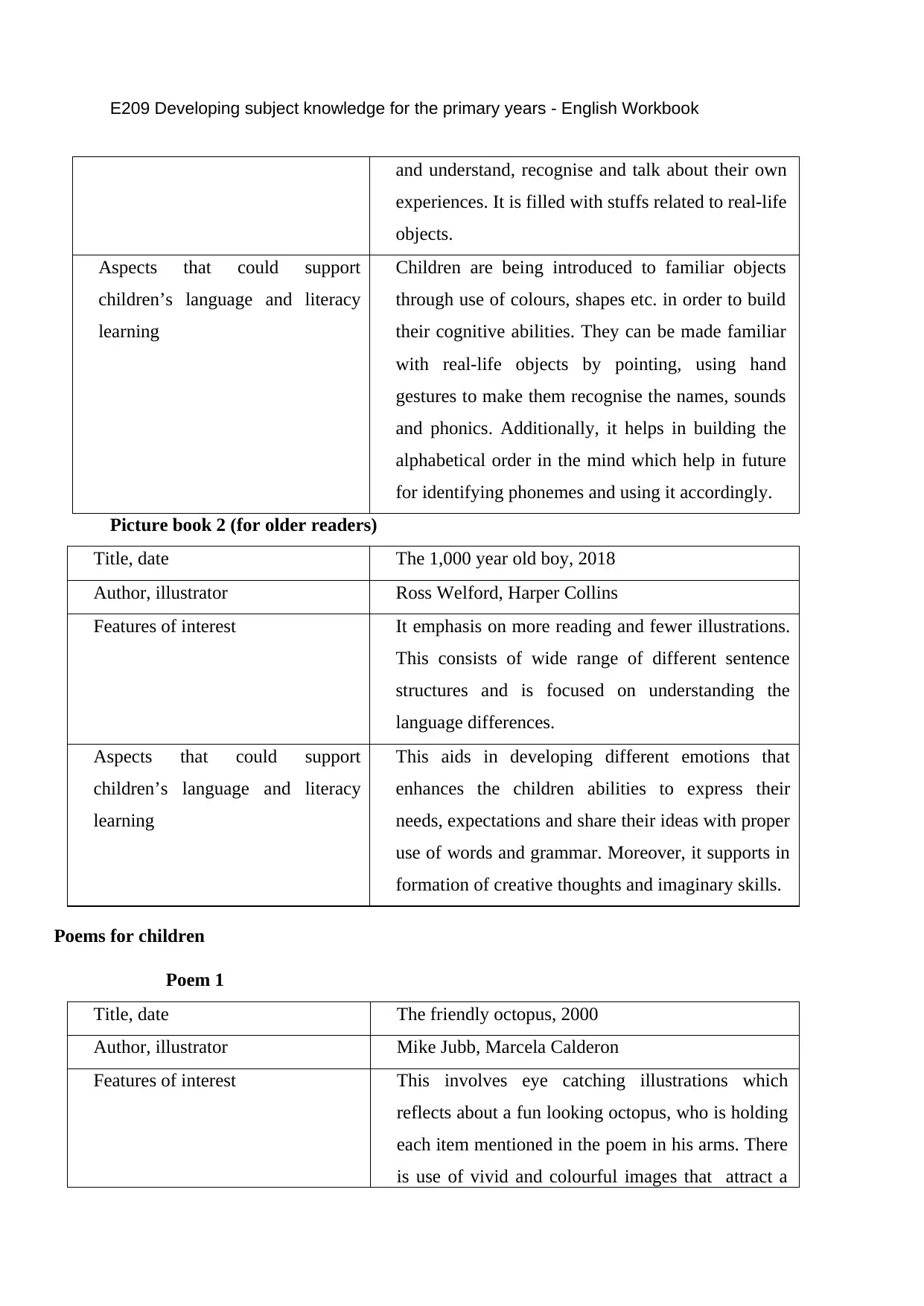
E209 Developing subject knowledge for the primary years - English Workbook
and understand, recognise and talk about their own
experiences. It is filled with stuffs related to real-life
objects.
Aspects that could support
children’s language and literacy
learning
Children are being introduced to familiar objects
through use of colours, shapes etc. in order to build
their cognitive abilities. They can be made familiar
with real-life objects by pointing, using hand
gestures to make them recognise the names, sounds
and phonics. Additionally, it helps in building the
alphabetical order in the mind which help in future
for identifying phonemes and using it accordingly.
Picture book 2 (for older readers)
Title, date The 1,000 year old boy, 2018
Author, illustrator Ross Welford, Harper Collins
Features of interest It emphasis on more reading and fewer illustrations.
This consists of wide range of different sentence
structures and is focused on understanding the
language differences.
Aspects that could support
children’s language and literacy
learning
This aids in developing different emotions that
enhances the children abilities to express their
needs, expectations and share their ideas with proper
use of words and grammar. Moreover, it supports in
formation of creative thoughts and imaginary skills.
Poems for children
Poem 1
Title, date The friendly octopus, 2000
Author, illustrator Mike Jubb, Marcela Calderon
Features of interest This involves eye catching illustrations which
reflects about a fun looking octopus, who is holding
each item mentioned in the poem in his arms. There
is use of vivid and colourful images that attract a
and understand, recognise and talk about their own
experiences. It is filled with stuffs related to real-life
objects.
Aspects that could support
children’s language and literacy
learning
Children are being introduced to familiar objects
through use of colours, shapes etc. in order to build
their cognitive abilities. They can be made familiar
with real-life objects by pointing, using hand
gestures to make them recognise the names, sounds
and phonics. Additionally, it helps in building the
alphabetical order in the mind which help in future
for identifying phonemes and using it accordingly.
Picture book 2 (for older readers)
Title, date The 1,000 year old boy, 2018
Author, illustrator Ross Welford, Harper Collins
Features of interest It emphasis on more reading and fewer illustrations.
This consists of wide range of different sentence
structures and is focused on understanding the
language differences.
Aspects that could support
children’s language and literacy
learning
This aids in developing different emotions that
enhances the children abilities to express their
needs, expectations and share their ideas with proper
use of words and grammar. Moreover, it supports in
formation of creative thoughts and imaginary skills.
Poems for children
Poem 1
Title, date The friendly octopus, 2000
Author, illustrator Mike Jubb, Marcela Calderon
Features of interest This involves eye catching illustrations which
reflects about a fun looking octopus, who is holding
each item mentioned in the poem in his arms. There
is use of vivid and colourful images that attract a
⊘ This is a preview!⊘
Do you want full access?
Subscribe today to unlock all pages.

Trusted by 1+ million students worldwide
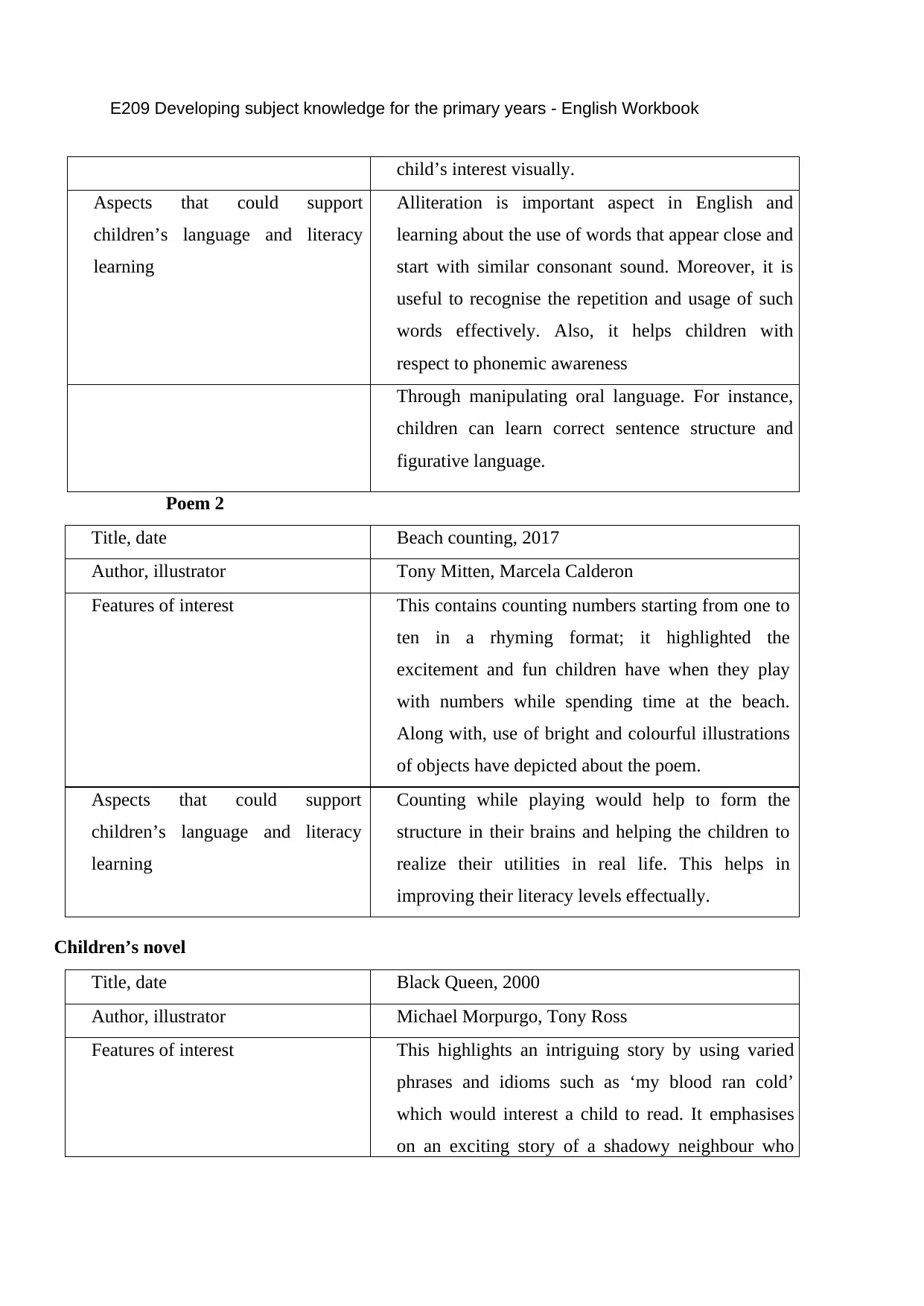
E209 Developing subject knowledge for the primary years - English Workbook
child’s interest visually.
Aspects that could support
children’s language and literacy
learning
Alliteration is important aspect in English and
learning about the use of words that appear close and
start with similar consonant sound. Moreover, it is
useful to recognise the repetition and usage of such
words effectively. Also, it helps children with
respect to phonemic awareness
Through manipulating oral language. For instance,
children can learn correct sentence structure and
figurative language.
Poem 2
Title, date Beach counting, 2017
Author, illustrator Tony Mitten, Marcela Calderon
Features of interest This contains counting numbers starting from one to
ten in a rhyming format; it highlighted the
excitement and fun children have when they play
with numbers while spending time at the beach.
Along with, use of bright and colourful illustrations
of objects have depicted about the poem.
Aspects that could support
children’s language and literacy
learning
Counting while playing would help to form the
structure in their brains and helping the children to
realize their utilities in real life. This helps in
improving their literacy levels effectually.
Children’s novel
Title, date Black Queen, 2000
Author, illustrator Michael Morpurgo, Tony Ross
Features of interest This highlights an intriguing story by using varied
phrases and idioms such as ‘my blood ran cold’
which would interest a child to read. It emphasises
on an exciting story of a shadowy neighbour who
child’s interest visually.
Aspects that could support
children’s language and literacy
learning
Alliteration is important aspect in English and
learning about the use of words that appear close and
start with similar consonant sound. Moreover, it is
useful to recognise the repetition and usage of such
words effectively. Also, it helps children with
respect to phonemic awareness
Through manipulating oral language. For instance,
children can learn correct sentence structure and
figurative language.
Poem 2
Title, date Beach counting, 2017
Author, illustrator Tony Mitten, Marcela Calderon
Features of interest This contains counting numbers starting from one to
ten in a rhyming format; it highlighted the
excitement and fun children have when they play
with numbers while spending time at the beach.
Along with, use of bright and colourful illustrations
of objects have depicted about the poem.
Aspects that could support
children’s language and literacy
learning
Counting while playing would help to form the
structure in their brains and helping the children to
realize their utilities in real life. This helps in
improving their literacy levels effectually.
Children’s novel
Title, date Black Queen, 2000
Author, illustrator Michael Morpurgo, Tony Ross
Features of interest This highlights an intriguing story by using varied
phrases and idioms such as ‘my blood ran cold’
which would interest a child to read. It emphasises
on an exciting story of a shadowy neighbour who
Paraphrase This Document
Need a fresh take? Get an instant paraphrase of this document with our AI Paraphraser
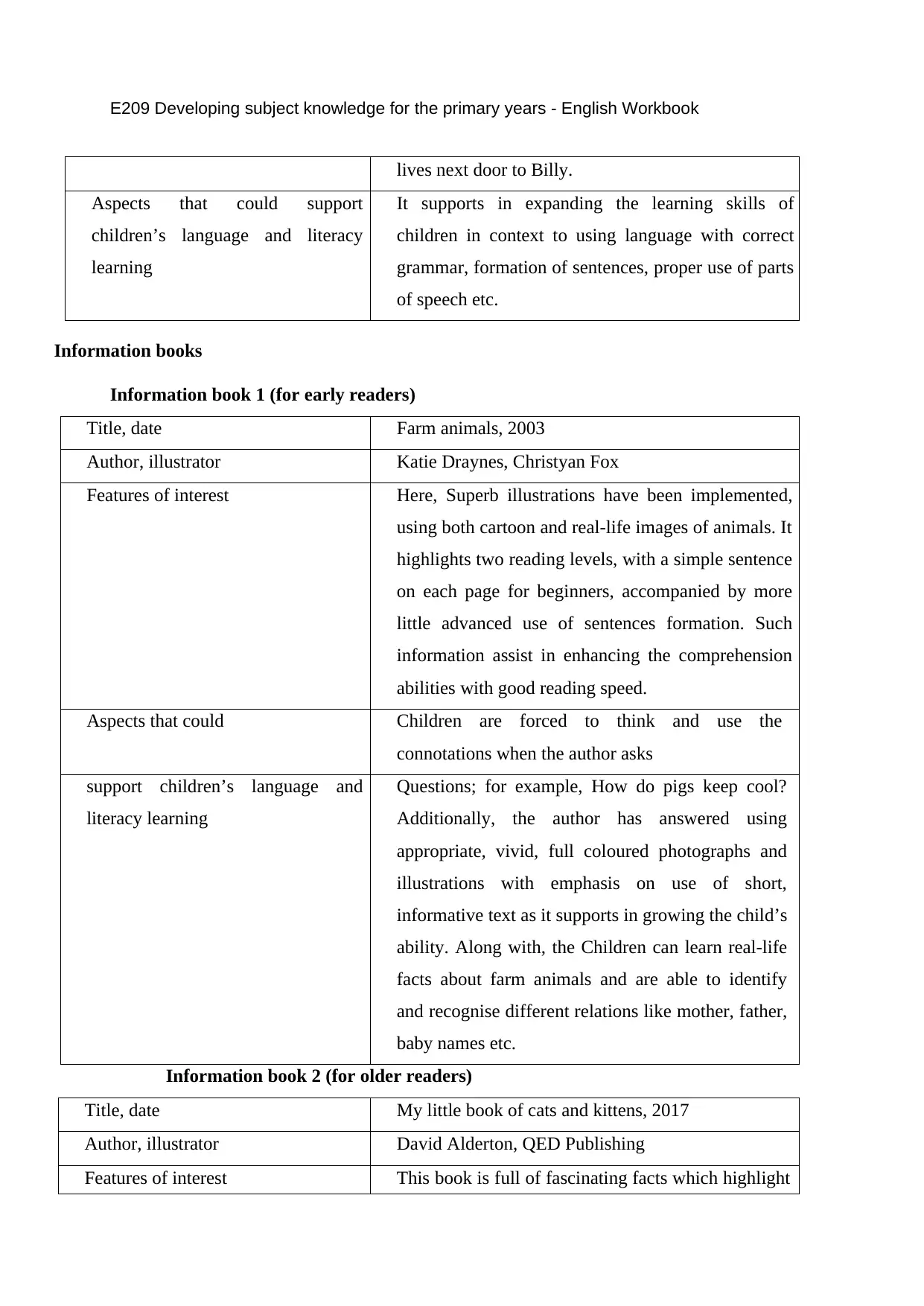
E209 Developing subject knowledge for the primary years - English Workbook
lives next door to Billy.
Aspects that could support
children’s language and literacy
learning
It supports in expanding the learning skills of
children in context to using language with correct
grammar, formation of sentences, proper use of parts
of speech etc.
Information books
Information book 1 (for early readers)
Title, date Farm animals, 2003
Author, illustrator Katie Draynes, Christyan Fox
Features of interest Here, Superb illustrations have been implemented,
using both cartoon and real-life images of animals. It
highlights two reading levels, with a simple sentence
on each page for beginners, accompanied by more
little advanced use of sentences formation. Such
information assist in enhancing the comprehension
abilities with good reading speed.
Aspects that could Children are forced to think and use the
connotations when the author asks
support children’s language and
literacy learning
Questions; for example, How do pigs keep cool?
Additionally, the author has answered using
appropriate, vivid, full coloured photographs and
illustrations with emphasis on use of short,
informative text as it supports in growing the child’s
ability. Along with, the Children can learn real-life
facts about farm animals and are able to identify
and recognise different relations like mother, father,
baby names etc.
Information book 2 (for older readers)
Title, date My little book of cats and kittens, 2017
Author, illustrator David Alderton, QED Publishing
Features of interest This book is full of fascinating facts which highlight
lives next door to Billy.
Aspects that could support
children’s language and literacy
learning
It supports in expanding the learning skills of
children in context to using language with correct
grammar, formation of sentences, proper use of parts
of speech etc.
Information books
Information book 1 (for early readers)
Title, date Farm animals, 2003
Author, illustrator Katie Draynes, Christyan Fox
Features of interest Here, Superb illustrations have been implemented,
using both cartoon and real-life images of animals. It
highlights two reading levels, with a simple sentence
on each page for beginners, accompanied by more
little advanced use of sentences formation. Such
information assist in enhancing the comprehension
abilities with good reading speed.
Aspects that could Children are forced to think and use the
connotations when the author asks
support children’s language and
literacy learning
Questions; for example, How do pigs keep cool?
Additionally, the author has answered using
appropriate, vivid, full coloured photographs and
illustrations with emphasis on use of short,
informative text as it supports in growing the child’s
ability. Along with, the Children can learn real-life
facts about farm animals and are able to identify
and recognise different relations like mother, father,
baby names etc.
Information book 2 (for older readers)
Title, date My little book of cats and kittens, 2017
Author, illustrator David Alderton, QED Publishing
Features of interest This book is full of fascinating facts which highlight
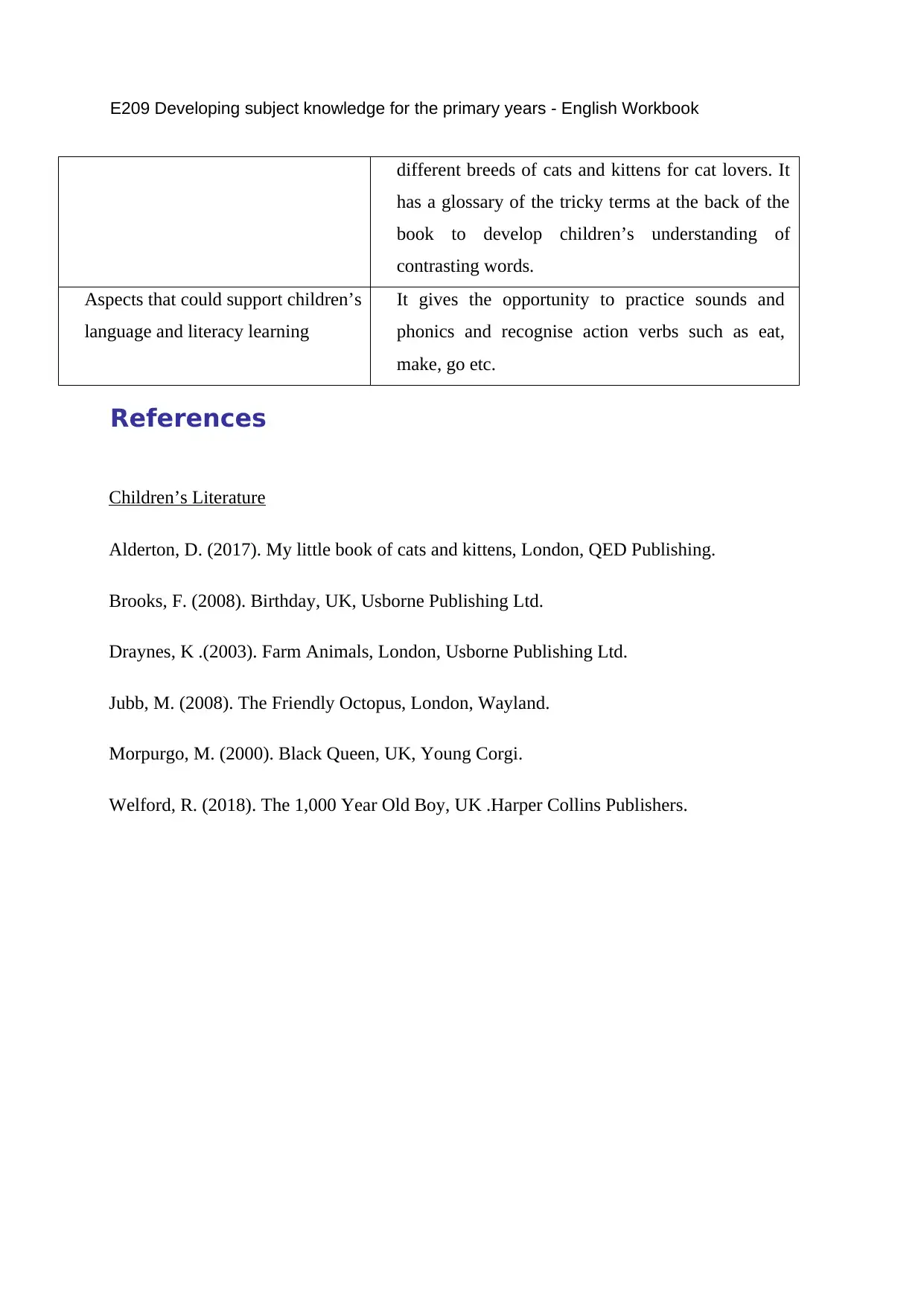
E209 Developing subject knowledge for the primary years - English Workbook
different breeds of cats and kittens for cat lovers. It
has a glossary of the tricky terms at the back of the
book to develop children’s understanding of
contrasting words.
Aspects that could support children’s
language and literacy learning
It gives the opportunity to practice sounds and
phonics and recognise action verbs such as eat,
make, go etc.
References
Children’s Literature
Alderton, D. (2017). My little book of cats and kittens, London, QED Publishing.
Brooks, F. (2008). Birthday, UK, Usborne Publishing Ltd.
Draynes, K .(2003). Farm Animals, London, Usborne Publishing Ltd.
Jubb, M. (2008). The Friendly Octopus, London, Wayland.
Morpurgo, M. (2000). Black Queen, UK, Young Corgi.
Welford, R. (2018). The 1,000 Year Old Boy, UK .Harper Collins Publishers.
different breeds of cats and kittens for cat lovers. It
has a glossary of the tricky terms at the back of the
book to develop children’s understanding of
contrasting words.
Aspects that could support children’s
language and literacy learning
It gives the opportunity to practice sounds and
phonics and recognise action verbs such as eat,
make, go etc.
References
Children’s Literature
Alderton, D. (2017). My little book of cats and kittens, London, QED Publishing.
Brooks, F. (2008). Birthday, UK, Usborne Publishing Ltd.
Draynes, K .(2003). Farm Animals, London, Usborne Publishing Ltd.
Jubb, M. (2008). The Friendly Octopus, London, Wayland.
Morpurgo, M. (2000). Black Queen, UK, Young Corgi.
Welford, R. (2018). The 1,000 Year Old Boy, UK .Harper Collins Publishers.
⊘ This is a preview!⊘
Do you want full access?
Subscribe today to unlock all pages.

Trusted by 1+ million students worldwide
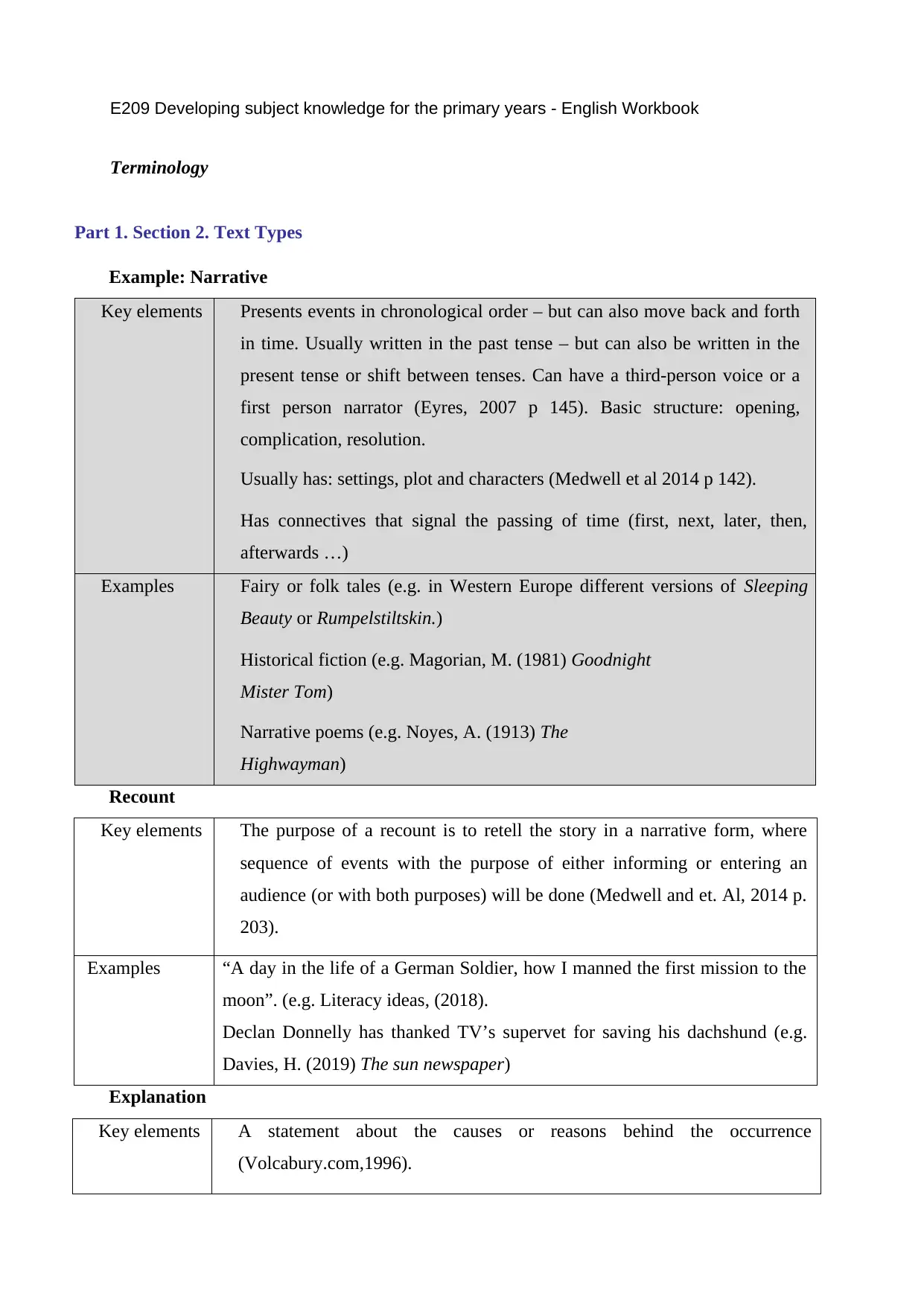
E209 Developing subject knowledge for the primary years - English Workbook
Terminology
Part 1. Section 2. Text Types
Example: Narrative
Key elements Presents events in chronological order – but can also move back and forth
in time. Usually written in the past tense – but can also be written in the
present tense or shift between tenses. Can have a third-person voice or a
first person narrator (Eyres, 2007 p 145). Basic structure: opening,
complication, resolution.
Usually has: settings, plot and characters (Medwell et al 2014 p 142).
Has connectives that signal the passing of time (first, next, later, then,
afterwards …)
Examples Fairy or folk tales (e.g. in Western Europe different versions of Sleeping
Beauty or Rumpelstiltskin.)
Historical fiction (e.g. Magorian, M. (1981) Goodnight
Mister Tom)
Narrative poems (e.g. Noyes, A. (1913) The
Highwayman)
Recount
Key elements The purpose of a recount is to retell the story in a narrative form, where
sequence of events with the purpose of either informing or entering an
audience (or with both purposes) will be done (Medwell and et. Al, 2014 p.
203).
Examples “A day in the life of a German Soldier, how I manned the first mission to the
moon”. (e.g. Literacy ideas, (2018).
Declan Donnelly has thanked TV’s supervet for saving his dachshund (e.g.
Davies, H. (2019) The sun newspaper)
Explanation
Key elements A statement about the causes or reasons behind the occurrence
(Volcabury.com,1996).
Terminology
Part 1. Section 2. Text Types
Example: Narrative
Key elements Presents events in chronological order – but can also move back and forth
in time. Usually written in the past tense – but can also be written in the
present tense or shift between tenses. Can have a third-person voice or a
first person narrator (Eyres, 2007 p 145). Basic structure: opening,
complication, resolution.
Usually has: settings, plot and characters (Medwell et al 2014 p 142).
Has connectives that signal the passing of time (first, next, later, then,
afterwards …)
Examples Fairy or folk tales (e.g. in Western Europe different versions of Sleeping
Beauty or Rumpelstiltskin.)
Historical fiction (e.g. Magorian, M. (1981) Goodnight
Mister Tom)
Narrative poems (e.g. Noyes, A. (1913) The
Highwayman)
Recount
Key elements The purpose of a recount is to retell the story in a narrative form, where
sequence of events with the purpose of either informing or entering an
audience (or with both purposes) will be done (Medwell and et. Al, 2014 p.
203).
Examples “A day in the life of a German Soldier, how I manned the first mission to the
moon”. (e.g. Literacy ideas, (2018).
Declan Donnelly has thanked TV’s supervet for saving his dachshund (e.g.
Davies, H. (2019) The sun newspaper)
Explanation
Key elements A statement about the causes or reasons behind the occurrence
(Volcabury.com,1996).
Paraphrase This Document
Need a fresh take? Get an instant paraphrase of this document with our AI Paraphraser
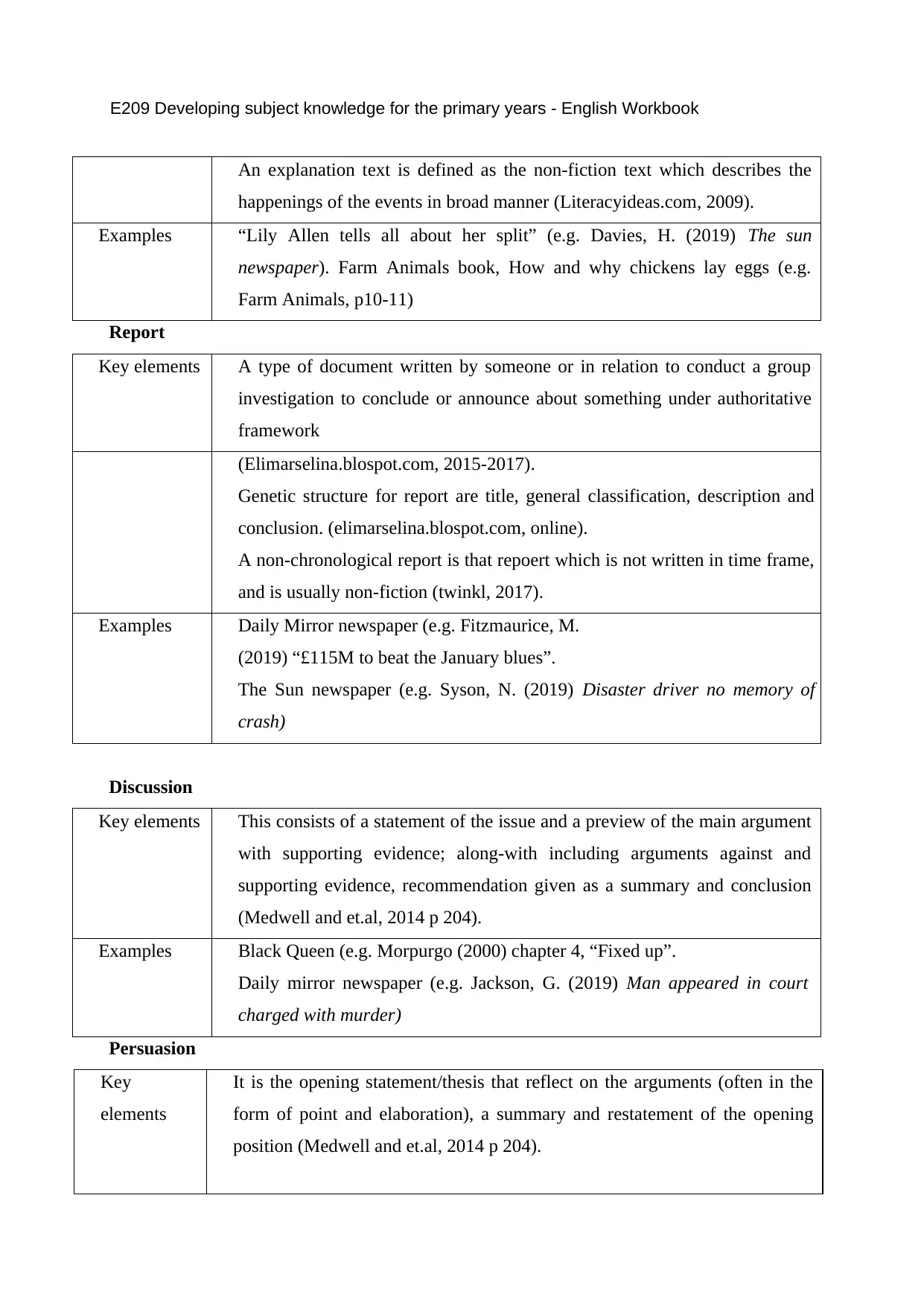
E209 Developing subject knowledge for the primary years - English Workbook
An explanation text is defined as the non-fiction text which describes the
happenings of the events in broad manner (Literacyideas.com, 2009).
Examples “Lily Allen tells all about her split” (e.g. Davies, H. (2019) The sun
newspaper). Farm Animals book, How and why chickens lay eggs (e.g.
Farm Animals, p10-11)
Report
Key elements A type of document written by someone or in relation to conduct a group
investigation to conclude or announce about something under authoritative
framework
(Elimarselina.blospot.com, 2015-2017).
Genetic structure for report are title, general classification, description and
conclusion. (elimarselina.blospot.com, online).
A non-chronological report is that repoert which is not written in time frame,
and is usually non-fiction (twinkl, 2017).
Examples Daily Mirror newspaper (e.g. Fitzmaurice, M.
(2019) “£115M to beat the January blues”.
The Sun newspaper (e.g. Syson, N. (2019) Disaster driver no memory of
crash)
Discussion
Key elements This consists of a statement of the issue and a preview of the main argument
with supporting evidence; along-with including arguments against and
supporting evidence, recommendation given as a summary and conclusion
(Medwell and et.al, 2014 p 204).
Examples Black Queen (e.g. Morpurgo (2000) chapter 4, “Fixed up”.
Daily mirror newspaper (e.g. Jackson, G. (2019) Man appeared in court
charged with murder)
Persuasion
Key
elements
It is the opening statement/thesis that reflect on the arguments (often in the
form of point and elaboration), a summary and restatement of the opening
position (Medwell and et.al, 2014 p 204).
An explanation text is defined as the non-fiction text which describes the
happenings of the events in broad manner (Literacyideas.com, 2009).
Examples “Lily Allen tells all about her split” (e.g. Davies, H. (2019) The sun
newspaper). Farm Animals book, How and why chickens lay eggs (e.g.
Farm Animals, p10-11)
Report
Key elements A type of document written by someone or in relation to conduct a group
investigation to conclude or announce about something under authoritative
framework
(Elimarselina.blospot.com, 2015-2017).
Genetic structure for report are title, general classification, description and
conclusion. (elimarselina.blospot.com, online).
A non-chronological report is that repoert which is not written in time frame,
and is usually non-fiction (twinkl, 2017).
Examples Daily Mirror newspaper (e.g. Fitzmaurice, M.
(2019) “£115M to beat the January blues”.
The Sun newspaper (e.g. Syson, N. (2019) Disaster driver no memory of
crash)
Discussion
Key elements This consists of a statement of the issue and a preview of the main argument
with supporting evidence; along-with including arguments against and
supporting evidence, recommendation given as a summary and conclusion
(Medwell and et.al, 2014 p 204).
Examples Black Queen (e.g. Morpurgo (2000) chapter 4, “Fixed up”.
Daily mirror newspaper (e.g. Jackson, G. (2019) Man appeared in court
charged with murder)
Persuasion
Key
elements
It is the opening statement/thesis that reflect on the arguments (often in the
form of point and elaboration), a summary and restatement of the opening
position (Medwell and et.al, 2014 p 204).
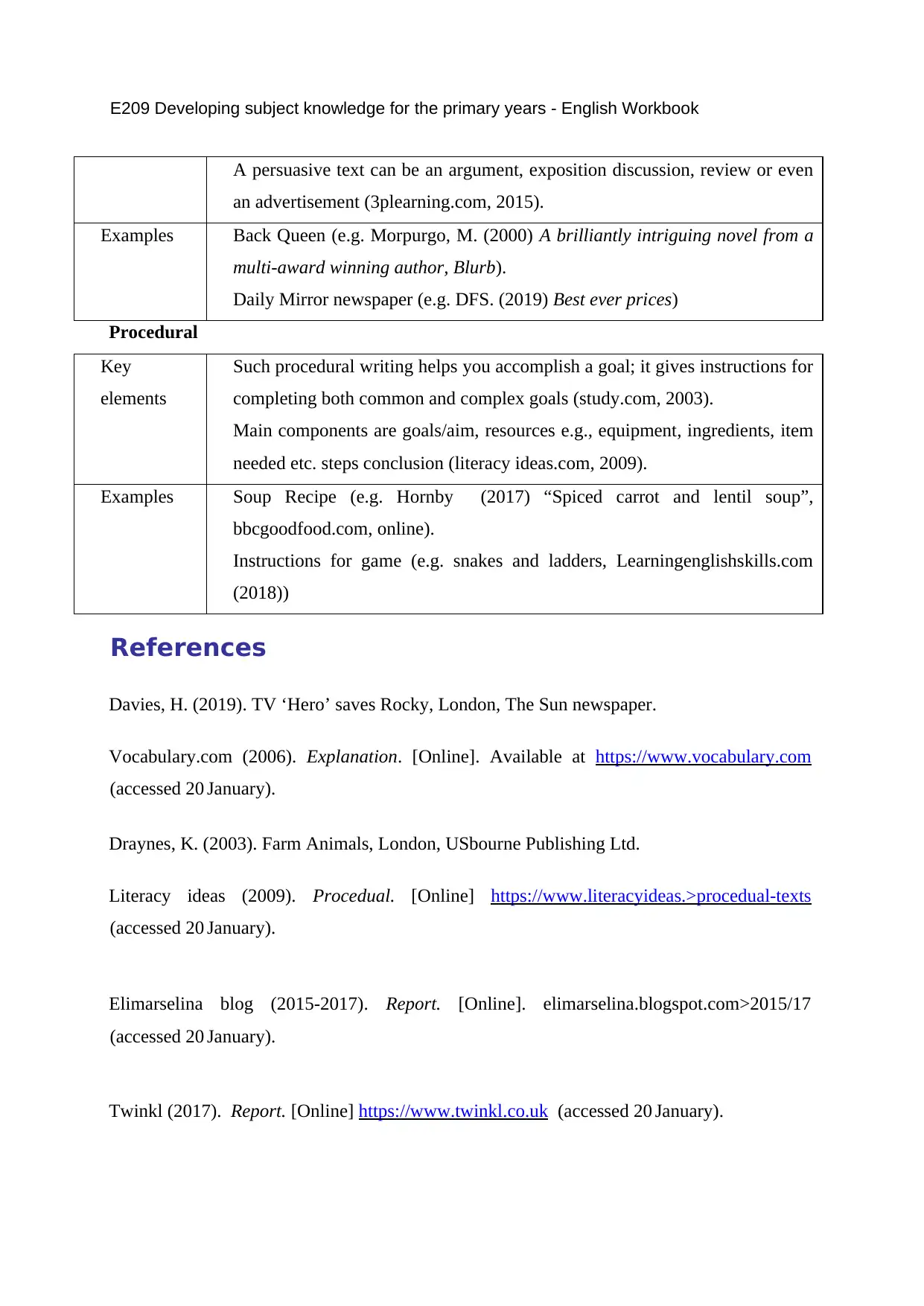
E209 Developing subject knowledge for the primary years - English Workbook
A persuasive text can be an argument, exposition discussion, review or even
an advertisement (3plearning.com, 2015).
Examples Back Queen (e.g. Morpurgo, M. (2000) A brilliantly intriguing novel from a
multi-award winning author, Blurb).
Daily Mirror newspaper (e.g. DFS. (2019) Best ever prices)
Procedural
Key
elements
Such procedural writing helps you accomplish a goal; it gives instructions for
completing both common and complex goals (study.com, 2003).
Main components are goals/aim, resources e.g., equipment, ingredients, item
needed etc. steps conclusion (literacy ideas.com, 2009).
Examples Soup Recipe (e.g. Hornby (2017) “Spiced carrot and lentil soup”,
bbcgoodfood.com, online).
Instructions for game (e.g. snakes and ladders, Learningenglishskills.com
(2018))
References
Davies, H. (2019). TV ‘Hero’ saves Rocky, London, The Sun newspaper.
Vocabulary.com (2006). Explanation. [Online]. Available at https://www.vocabulary.com
(accessed 20 January).
Draynes, K. (2003). Farm Animals, London, USbourne Publishing Ltd.
Literacy ideas (2009). Procedual. [Online] https://www.literacyideas.>procedual-texts
(accessed 20 January).
Elimarselina blog (2015-2017). Report. [Online]. elimarselina.blogspot.com>2015/17
(accessed 20 January).
Twinkl (2017). Report. [Online] https://www.twinkl.co.uk (accessed 20 January).
A persuasive text can be an argument, exposition discussion, review or even
an advertisement (3plearning.com, 2015).
Examples Back Queen (e.g. Morpurgo, M. (2000) A brilliantly intriguing novel from a
multi-award winning author, Blurb).
Daily Mirror newspaper (e.g. DFS. (2019) Best ever prices)
Procedural
Key
elements
Such procedural writing helps you accomplish a goal; it gives instructions for
completing both common and complex goals (study.com, 2003).
Main components are goals/aim, resources e.g., equipment, ingredients, item
needed etc. steps conclusion (literacy ideas.com, 2009).
Examples Soup Recipe (e.g. Hornby (2017) “Spiced carrot and lentil soup”,
bbcgoodfood.com, online).
Instructions for game (e.g. snakes and ladders, Learningenglishskills.com
(2018))
References
Davies, H. (2019). TV ‘Hero’ saves Rocky, London, The Sun newspaper.
Vocabulary.com (2006). Explanation. [Online]. Available at https://www.vocabulary.com
(accessed 20 January).
Draynes, K. (2003). Farm Animals, London, USbourne Publishing Ltd.
Literacy ideas (2009). Procedual. [Online] https://www.literacyideas.>procedual-texts
(accessed 20 January).
Elimarselina blog (2015-2017). Report. [Online]. elimarselina.blogspot.com>2015/17
(accessed 20 January).
Twinkl (2017). Report. [Online] https://www.twinkl.co.uk (accessed 20 January).
⊘ This is a preview!⊘
Do you want full access?
Subscribe today to unlock all pages.

Trusted by 1+ million students worldwide
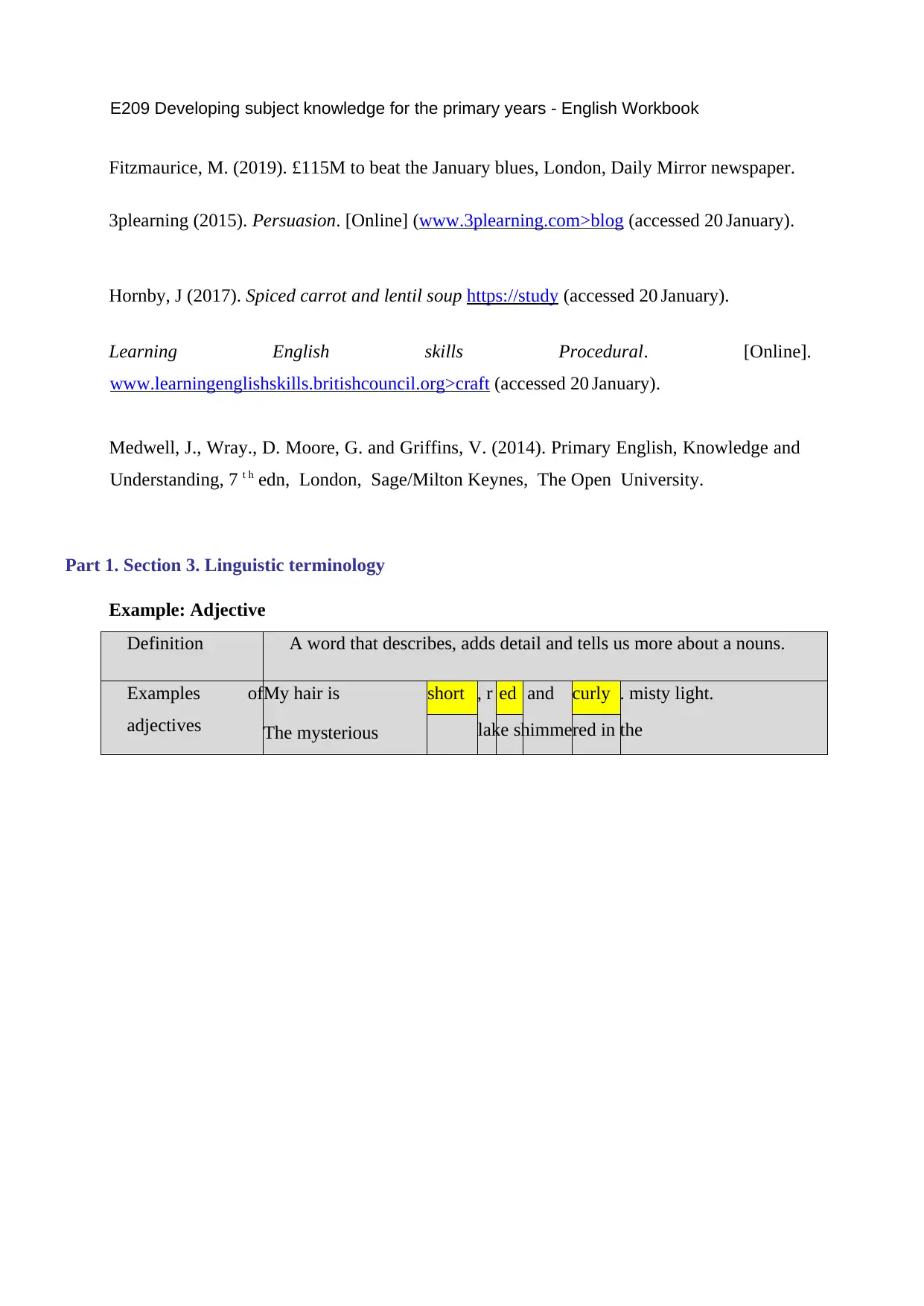
E209 Developing subject knowledge for the primary years - English Workbook
Fitzmaurice, M. (2019). £115M to beat the January blues, London, Daily Mirror newspaper.
3plearning (2015). Persuasion. [Online] (www.3plearning.com>blog (accessed 20 January).
Hornby, J (2017). Spiced carrot and lentil soup https://study (accessed 20 January).
Learning English skills Procedural. [Online].
www.learningenglishskills.britishcouncil.org>craft (accessed 20 January).
Medwell, J., Wray., D. Moore, G. and Griffins, V. (2014). Primary English, Knowledge and
Understanding, 7 t h edn, London, Sage/Milton Keynes, The Open University.
Part 1. Section 3. Linguistic terminology
Example: Adjective
Definition A word that describes, adds detail and tells us more about a nouns.
Examples of
adjectives
My hair is
The mysterious
short , r ed and curly . misty light.
lake shimmered in the
Fitzmaurice, M. (2019). £115M to beat the January blues, London, Daily Mirror newspaper.
3plearning (2015). Persuasion. [Online] (www.3plearning.com>blog (accessed 20 January).
Hornby, J (2017). Spiced carrot and lentil soup https://study (accessed 20 January).
Learning English skills Procedural. [Online].
www.learningenglishskills.britishcouncil.org>craft (accessed 20 January).
Medwell, J., Wray., D. Moore, G. and Griffins, V. (2014). Primary English, Knowledge and
Understanding, 7 t h edn, London, Sage/Milton Keynes, The Open University.
Part 1. Section 3. Linguistic terminology
Example: Adjective
Definition A word that describes, adds detail and tells us more about a nouns.
Examples of
adjectives
My hair is
The mysterious
short , r ed and curly . misty light.
lake shimmered in the
Paraphrase This Document
Need a fresh take? Get an instant paraphrase of this document with our AI Paraphraser
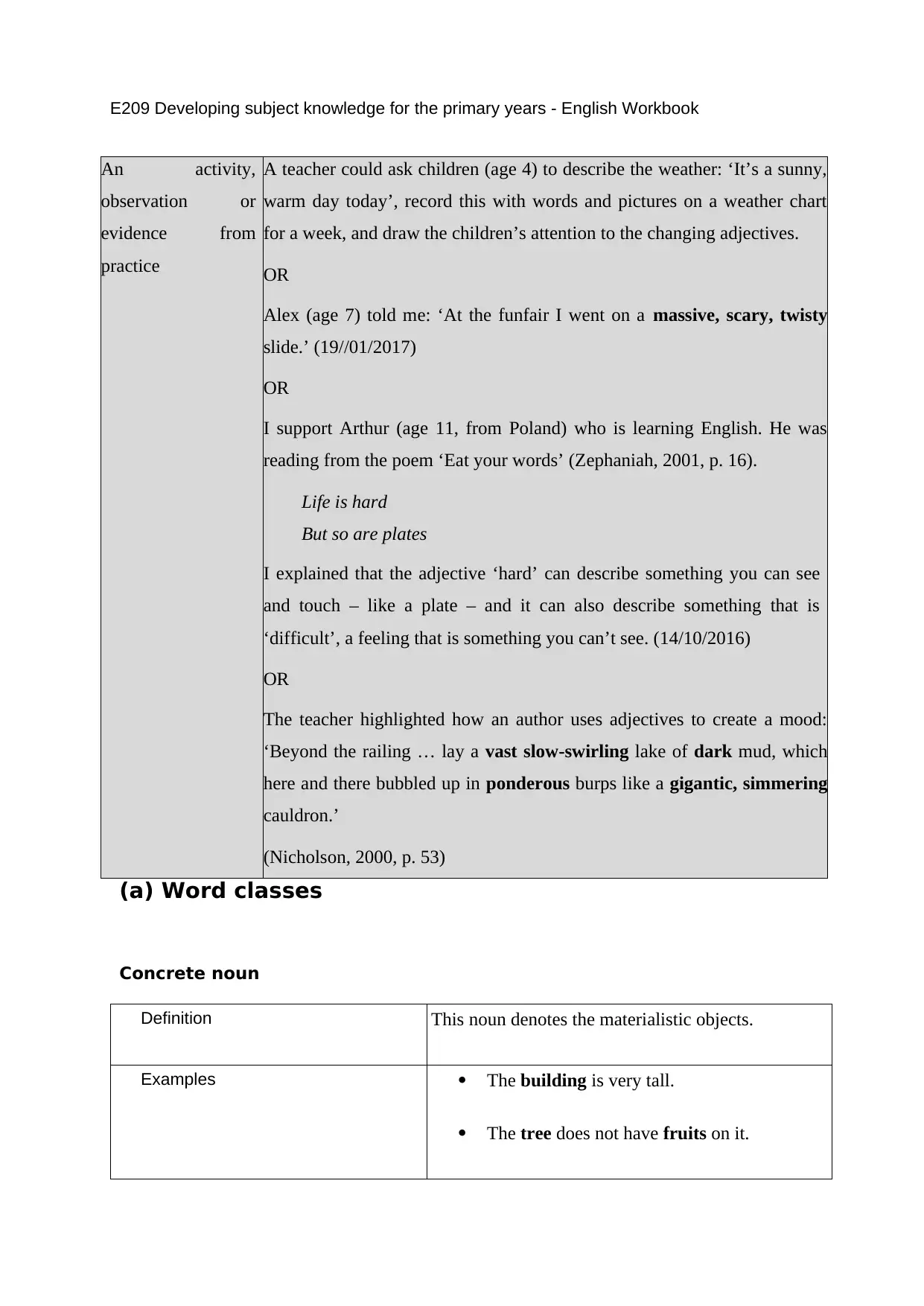
E209 Developing subject knowledge for the primary years - English Workbook
An activity,
observation or
evidence from
practice
A teacher could ask children (age 4) to describe the weather: ‘It’s a sunny,
warm day today’, record this with words and pictures on a weather chart
for a week, and draw the children’s attention to the changing adjectives.
OR
Alex (age 7) told me: ‘At the funfair I went on a massive, scary, twisty
slide.’ (19//01/2017)
OR
I support Arthur (age 11, from Poland) who is learning English. He was
reading from the poem ‘Eat your words’ (Zephaniah, 2001, p. 16).
Life is hard
But so are plates
I explained that the adjective ‘hard’ can describe something you can see
and touch – like a plate – and it can also describe something that is
‘difficult’, a feeling that is something you can’t see. (14/10/2016)
OR
The teacher highlighted how an author uses adjectives to create a mood:
‘Beyond the railing … lay a vast slow-swirling lake of dark mud, which
here and there bubbled up in ponderous burps like a gigantic, simmering
cauldron.’
(Nicholson, 2000, p. 53)
(a) Word classes
Concrete noun
Definition This noun denotes the materialistic objects.
Examples The building is very tall.
The tree does not have fruits on it.
An activity,
observation or
evidence from
practice
A teacher could ask children (age 4) to describe the weather: ‘It’s a sunny,
warm day today’, record this with words and pictures on a weather chart
for a week, and draw the children’s attention to the changing adjectives.
OR
Alex (age 7) told me: ‘At the funfair I went on a massive, scary, twisty
slide.’ (19//01/2017)
OR
I support Arthur (age 11, from Poland) who is learning English. He was
reading from the poem ‘Eat your words’ (Zephaniah, 2001, p. 16).
Life is hard
But so are plates
I explained that the adjective ‘hard’ can describe something you can see
and touch – like a plate – and it can also describe something that is
‘difficult’, a feeling that is something you can’t see. (14/10/2016)
OR
The teacher highlighted how an author uses adjectives to create a mood:
‘Beyond the railing … lay a vast slow-swirling lake of dark mud, which
here and there bubbled up in ponderous burps like a gigantic, simmering
cauldron.’
(Nicholson, 2000, p. 53)
(a) Word classes
Concrete noun
Definition This noun denotes the materialistic objects.
Examples The building is very tall.
The tree does not have fruits on it.
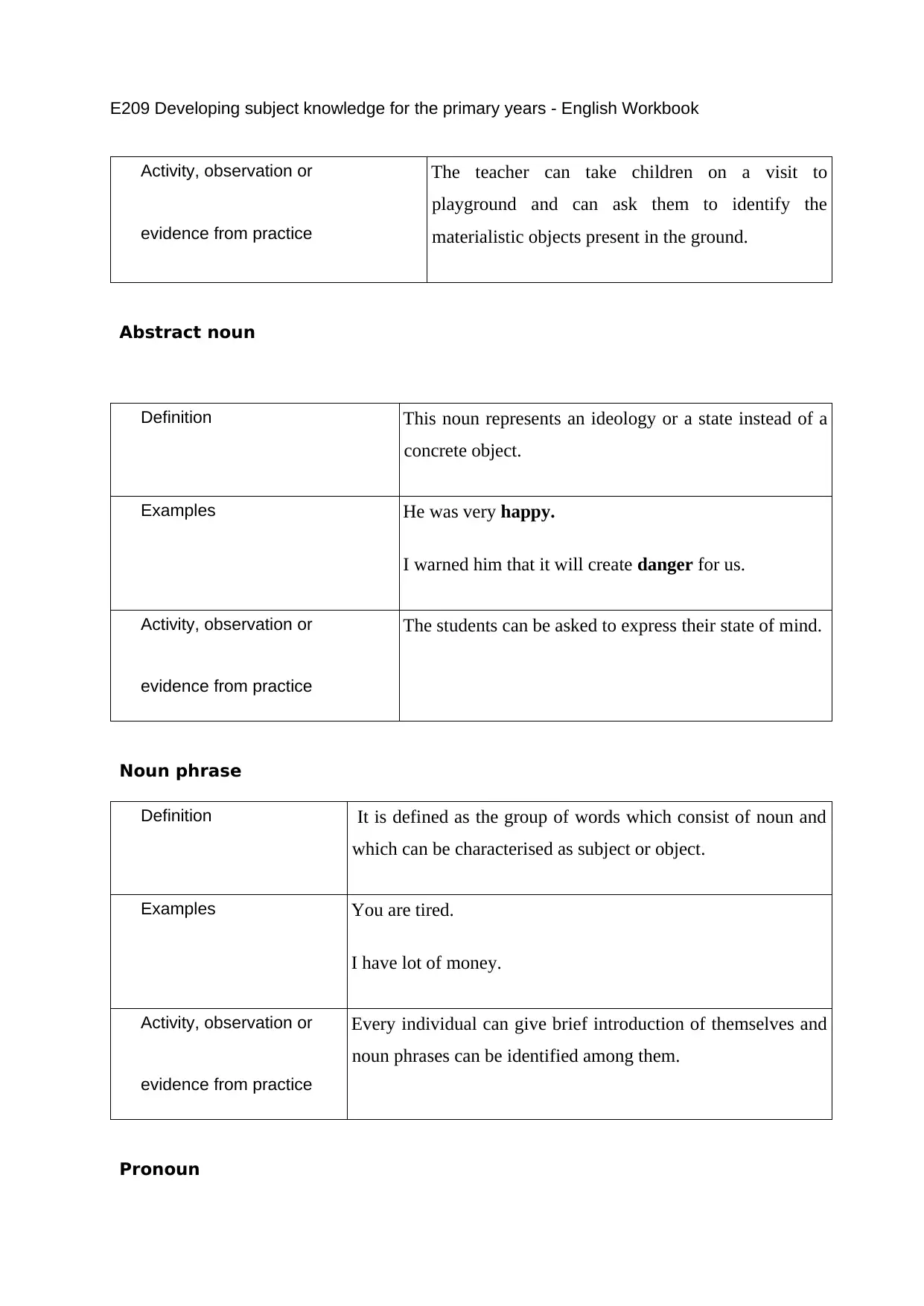
E209 Developing subject knowledge for the primary years - English Workbook
Activity, observation or
evidence from practice
The teacher can take children on a visit to
playground and can ask them to identify the
materialistic objects present in the ground.
Abstract noun
Definition This noun represents an ideology or a state instead of a
concrete object.
Examples He was very happy.
I warned him that it will create danger for us.
Activity, observation or
evidence from practice
The students can be asked to express their state of mind.
Noun phrase
Definition It is defined as the group of words which consist of noun and
which can be characterised as subject or object.
Examples You are tired.
I have lot of money.
Activity, observation or
evidence from practice
Every individual can give brief introduction of themselves and
noun phrases can be identified among them.
Pronoun
Activity, observation or
evidence from practice
The teacher can take children on a visit to
playground and can ask them to identify the
materialistic objects present in the ground.
Abstract noun
Definition This noun represents an ideology or a state instead of a
concrete object.
Examples He was very happy.
I warned him that it will create danger for us.
Activity, observation or
evidence from practice
The students can be asked to express their state of mind.
Noun phrase
Definition It is defined as the group of words which consist of noun and
which can be characterised as subject or object.
Examples You are tired.
I have lot of money.
Activity, observation or
evidence from practice
Every individual can give brief introduction of themselves and
noun phrases can be identified among them.
Pronoun
⊘ This is a preview!⊘
Do you want full access?
Subscribe today to unlock all pages.

Trusted by 1+ million students worldwide
1 out of 37
Related Documents
Your All-in-One AI-Powered Toolkit for Academic Success.
+13062052269
info@desklib.com
Available 24*7 on WhatsApp / Email
![[object Object]](/_next/static/media/star-bottom.7253800d.svg)
Unlock your academic potential
Copyright © 2020–2025 A2Z Services. All Rights Reserved. Developed and managed by ZUCOL.





